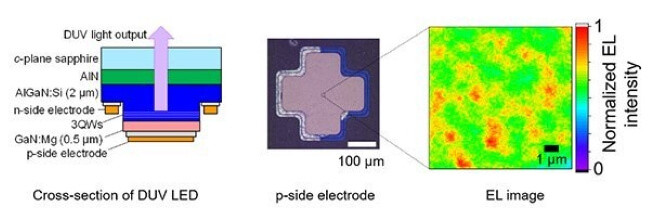Scientist Develop Fast UV LED for Li-Fi
| 12-08-2020 | By Robin Mitchell
Scientists have solved several major problems that many optical wireless communication systems suffer from. What is Deep UV, what is Li-Fi, and how will this new development help Li-Fi technologies?
What is Deep Ultraviolet light (UV Light)?
Deep ultraviolet light is UV light with a frequency between 100nm to 280nm, and is entirely invisible to the naked eye. While all UV is invisible, most UV light sources have a purple hue as they cannot produce pure UV light of a specific frequency, and instead produce a broad spectrum of light. One strong characteristic of deep UV is its highly ionising properties, and as such is commonly found in applications involving sterilisation. An LED that emits deep UV is called a Deep UV LED, and has a range of advantages over traditional UV bulbs and tubes. For example, such LEDs have no warmup time (while fluorescent tubes require an initial heating stage), can be quickly modulated, and are very energy efficient.
What is Li-F and How Does it Work?
Li-Fi, which stands for Light Fidelity, is a form of Wi-Fi that uses light instead of radio waves to transmit information. The wavelength of light that can be used in Li-Fi is broad ranging from the infrared to the UV spectrum, with each wavelength providing its own benefits. While visible light communication has existed for years (such as IR ports), Li-Fi is a technology that has only existed since 2011.
Li-Fi vs. WI-Fi
Li-Fi has several advantages over Wi-Fi due to the use of light instead of radio waves. The first is that Li-Fi cannot interfere with radio equipment, and thus can be safely used in areas that are sensitive to radio transmission (such as airplanes, scientific equipment etc.). Li-Fi also has a theoretical maximum data speed of 100Gbps, while the latest version of Wi-Fi only has a theoretical maximum of 1.7Gbps. Of course, Li-Fi does have several major disadvantages that would prevent many users from deploying the technology in their homes. The first is that devices require a direct line of sight from a transmitter (as a light beam needs to reach the device). The second is that Li-Fi generally has a much shorter range than Wi-Fi, with Wi-Fi working as far as 100 meters, while Li-Fi has a range in the meters. The third drawback of Li-Fi systems is the need for specialist light transmitters. Li-Fi systems integrated into house bulbs do exist, but they require the use of an LED light bulb, and some do not like the harsh light emitted by such bulbs. The fourth drawback of Li-Fi systems is ambient light; the more ambient light present, the more difficult it is to transmit information.
Scientists create new Deep UV LED
To help solve some of the drawbacks present in Li-Fi systems, a team of researchers have developed a miniature deep UV LED that provides both speed and reduction in ambient light interference. The researchers, who are based in Japan, decided to focus on reducing the size of the LED, as this helps to reduce the time needed to switch the LED on and off, thus increasing the maximum data rate. However, reducing the size of an LED also reduces its output power, thereby reducing its maximum range. To solve this issue, the team decided to integrate multiple deep UV LEDs into a single package to produce an ultra-fast LED capable of high data-transmission rates while also providing the power needed for reasonable range. Another issue faced by Li-Fi systems is ambient light; sources of light such as the sun can interfere with Li-Fi systems making them ineffective in bright areas. The use of deep UV helps to solve this issue as deep UV, which is invisible to the naked eye, is emitted in very small quantities (if at all), by the sun and other light sources.

Credit: Kazunobu Kojima, Tohoku University
However, the use of deep UV as a medium of data transmission does raise questions regarding its safety. While individual transmitters would most likely emit harmless levels of UV, ionising radiation is still being emitted. Unlike Wi-Fi or other radio-based technologies, the wavelengths used in deep UV applications are capable of sterilising equipment (albeit under high concentration). The adverse health effects of such a technology could be better understood if data regarding power outputs of sterilising equipment and Li-Fi systems could be compared side-by-side.
Read More

